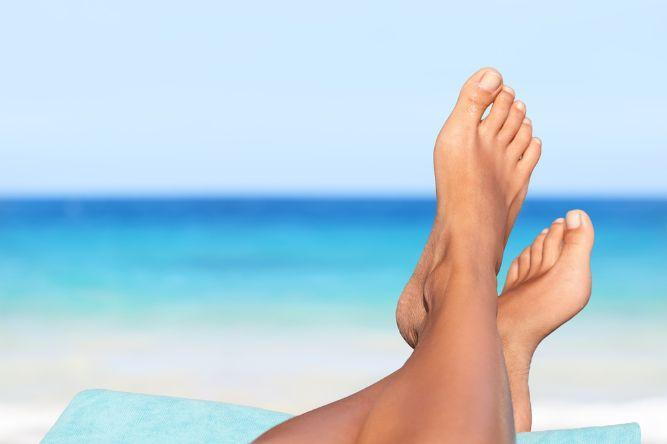The Sun & Your Feet: Summer Foot Care Tips
posted: May 16, 2022.

When the sun is out, and the snow melts away, it’s a sign that summer has begun. So many people are eager to swap their shoes for flip-flops and hit the beach as soon as the temperature rises. While the prospect of summer arriving can be overwhelmingly exciting, it can be easy to forget about the sun’s UV rays when you’re working on your tan. It’s important to get that sun lotion on early before you get too toasty. It’s equally integral to remember that while your skin needs protecting, your feet do too.
Here are some summer foot care tips to ensure you keep everything healthy from your heels to your toes:
Sunblock
The obvious go-to in the summer is sunblock. Some people may not realize how intensely the sun’s UV rays damage our bodies. They can cause skin cancer, damage to your eyes, and premature aging of the skin. Your skin is the most vulnerable part of the body when it comes to the effects of the sun. You can reduce the threat from the application of sunscreen.
The Top Sunscreen Practices
Apply sunscreen 15-20 minutes before you go out into the sun. It’s pivotal to apply sunscreen rain or shine, even when there are clouds. The reason for this is because of the UV rating.
Make sure you’re applying sunscreen to both sides of your feet. Most people forget to put on sunscreen under the soles of their feet when they’re planning to hit the beach.
Remember to reapply sunscreen after you’ve been in the water. Any sunblock that you’ve applied beforehand will potentially wash off while you’re going for a swim. Look for a broad-spectrum and water-resistant lotion that has UVA and UVB protection, as it helps prevent skin cancer.
It’s recommended to use a sunscreen with a minimum of SPF 30 or higher, which blocks 97% of UVA rays.
Reapply sunscreen every 2 hours. Water, sweat, and drying off can reduce the effectiveness of the sunscreen as it rubs off. Reapply sunscreen as often as possible for maximum skin protection.
Sunburn Treatment
If you’ve been exposed to too much sun, your skin may feel as though it’s burning. This is a sign that you’ve got a little too much of the sun’s ultraviolet radiation instead.
Common symptoms of sunburns include:
Changes in skin tone
Skin that feels warm/hot to the touch
Pain, tenderness, and/or swelling
Blisters
Headaches/fevers
A mild sunburn may be manageable, but it can also become a very serious problem, as too much sun damage can lead to cancerous skin changes.
There are various home remedies you can use to relieve the pain associated with sunburns, especially when they’re on your feet:
Apply aloe vera to soothe your skin.
Don’t pop any blisters; let them heal on their own.
Keep your feet elevated.
Use medication to reduce the pain and heal sunburns.
Stay hydrated.
Soak your feet in cold water or milk (yes, this is real).
Foot Checks
Checking your feet regularly during the summer can help you find any abnormalities. Look out for any dark patches of skin, the sudden formation of moles, or any other suspicious spots.
The ABCDE Method
To know what should be a cause for concern, follow the ABCDE method:
A: Asymmetrical
B: Border
C: Colour
D: Diametre
E: Evolution
This method allows you to analyze your feet and determine anything that seems out of the ordinary.
Common Summer Foot Conditions
The hot conditions that come around during those sweltering summers can cause the development of many food conditions.
Some common summer foot conditions are:
Blisters: A blister forms when fluid-filled bubbles occur under the top layer of your skin due to the moisture from the heat or excessive foot sweat. You can combat blisters by using moisturizer, foot powders, wearing moisture-wicking socks, and properly-fitted shoes.
Cracked Heels: The summer heat can make you more prone to dry skin, which results in your heels cracking. Moisturize your feet regularly to avoid skin cracking, as the summertime can tempt many people to go barefoot quite often.
Corns: You can develop corns from wearing shoes that don’t fit you properly. In the case of the summer, these can be flip-flops or any other ill-fitting footwear that puts pressure on your feet.
Plantar Fasciitis: Flip-flops don’t give your feet enough arch support, putting a lot of pressure and stress on your plantar. Eventually, the stress can lead to plantar fasciitis.
Your feet are a lot more important than you realize. With so many intricate functions and vulnerabilities, it’s paramount to keep them healthy. Visit our clinic today to get the best foot care from a reliable Chiropodist in Toronto. We have many services, and licenced Foot Specialists are here to help you put your best foot forward.